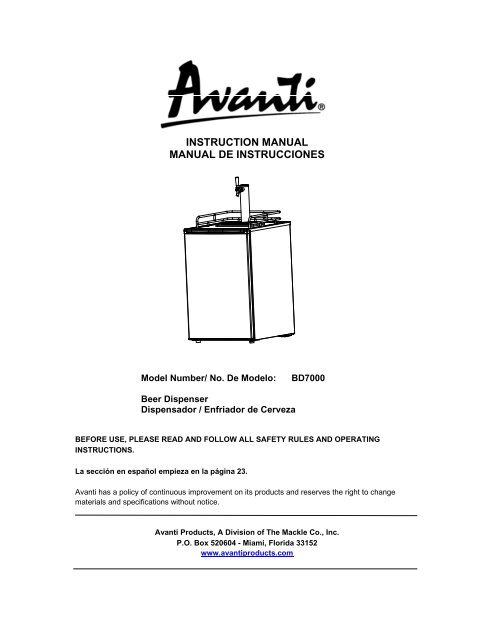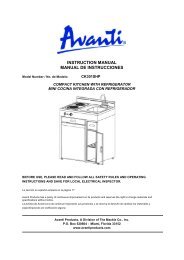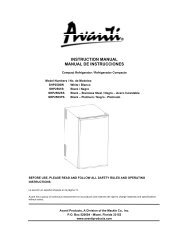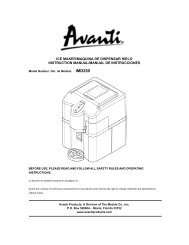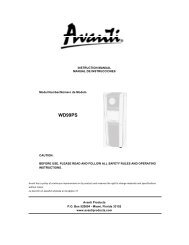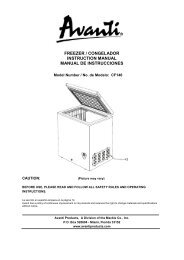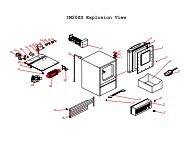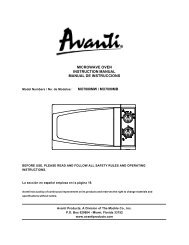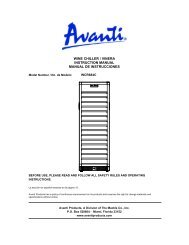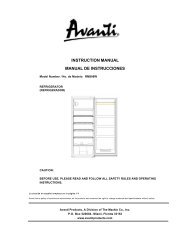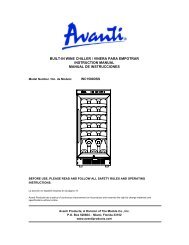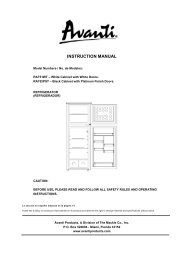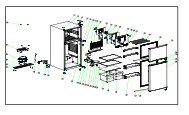instruction manual manual de instrucciones - Designer Appliances
instruction manual manual de instrucciones - Designer Appliances
instruction manual manual de instrucciones - Designer Appliances
You also want an ePaper? Increase the reach of your titles
YUMPU automatically turns print PDFs into web optimized ePapers that Google loves.
INSTRUCTION MANUALMANUAL DE INSTRUCCIONESMo<strong>de</strong>l Number/ No. De Mo<strong>de</strong>lo:BD7000Beer DispenserDispensador / Enfriador <strong>de</strong> CervezaBEFORE USE, PLEASE READ AND FOLLOW ALL SAFETY RULES AND OPERATINGINSTRUCTIONS.La sección en español empieza en la página 23.Avanti has a policy of continuous improvement on its products and reserves the right to changematerials and specifications without notice.Avanti Products, A Division of The Mackle Co., Inc.P.O. Box 520604 - Miami, Florida 33152www.avantiproducts.com
Table of ContentsAppliance Safety 3Important Safegui<strong>de</strong>s 4Help Us Help You 5Parts and Features 6 – 7Important Safety Instructions 8Installation Instructions 8Before Using Your Appliance 8Installation of Your Appliance 8Electrical Connection 9Reversing the Door Swing of Your Appliance 10Installing and Assembling Your Appliance 10 – 14Converting Your Beer Dispenser to an ALL-Refrigerator Unit 14Operating Your Appliance 15Temperature Control 15Defrosting Your Appliance 15Care and Maintenance 15Cleaning Your Appliance 15Vacation Time 15Moving Your Appliance 15Draught Beer Trouble Gui<strong>de</strong> 16 – 20Troubleshooting Gui<strong>de</strong> 21Service for Your Appliance 21Your Avanti Products Warranty 22Instrucciones en Español 23 – 33Registration Information and Registration Card 352
BEER DISPENSER SAFETYYour safety and the safety of others are very important.We have provi<strong>de</strong>d many important safety messages in this <strong>manual</strong> for your appliance. Always readand obey all safety messages.This is the Safety Alert Symbol. This symbol alerts you to potential hazards thatcan kill or injure you and others. All safety messages will follow the SafetyAlert Symbol and either the words” DANGER”, “WARNING” or “CAUTION”.Danger means that failure to heed thissafety statement may result in severepersonal injury or <strong>de</strong>ath.Warning means that failure to heed thissafety statement may result in extensiveproduct damage, serious personal injury, or<strong>de</strong>ath.Caution means that failure to heed thissafety statement may result in minor ormo<strong>de</strong>rate personal injury, property orequipment damage.All safety messages will alert to know what potential hazard is, tell you how to reduce the chance ofinjury, and let you know what can happen if the <strong>instruction</strong>s are not followed.3
IMPORTANT SAFEGUIDESBefore the appliance is used, it must be properly positioned and installed as<strong>de</strong>scribed in this <strong>manual</strong>,so read the <strong>manual</strong> carefully. To reduce the risk of fire,electrical shock or injury when using the appliance, follow basic precaution,including the following:Plug into a groun<strong>de</strong>d 3-prong outlet, do not remove grounding prong, do not use an adapter, anddo not use an extension cord.Replace all panels before operating.It is recommen<strong>de</strong>d that a separate circuit, serving only your appliance be provi<strong>de</strong>d. Usereceptacles that cannot be turned off by a switch or pull chain.Never clean appliance parts with flammable fluids. These fumes can create a fire hazard orexplosion. And do not store or use gasoline or other flammable vapors and liquids in the vicinity ofthis or any other appliance. The fumes can create a fire hazard or explosion.Before proceeding with cleaning and maintenance operations, make sure the power line of theunit is disconnected.Do not connect or disconnect the electric plug when your hands are wet.Unplug the appliance or disconnect power before cleaning or servicing. Failure to do so can resultin electrical shock or <strong>de</strong>ath.Do not attempt to repair or replace any part of your appliance unless it is specificallyrecommen<strong>de</strong>d in this <strong>manual</strong>. All other servicing should be referred to a qualified technician.FOLLOW WARNING CALL OUTS BELOW ONLY WHEN APPLICABLE TO YOUR MODELUse two or more people to move and install appliance. Failure to do so can result in back or otherinjury.To ensure proper ventilation for your appliance, the front of the unit must be completelyunobstructed. Choose a well-ventilated area with temperatures above 60°F (16°C) and below90°F (32°C). This unit must be installed in an area protected from the element, such as wind, rain,water spray or drips.The appliance should not be located next to ovens, grills or other sources of high heat.The appliance must be installed with all electrical, water and drain connections in accordance withstate and local co<strong>de</strong>s. A standard electrical supply (115 V AC only, 60 Hz), properly groun<strong>de</strong>d inaccordance with the National Electrical Co<strong>de</strong> and local co<strong>de</strong>s and ordinances is required.Do not kink or pinch the power supply cord of appliance.The fuse (or circuit breaker) size should be 15 amperes.It is important for the appliance to be leveled in or<strong>de</strong>r to work properly. You may need to makeseveral adjustments to level it.All installation must be in accordance with local plumbing co<strong>de</strong> requirements.Make certain that the pipes are not pinched or kinked or damaged during installations.Check for leaks after connection.Never allow children to operate, play with or crawl insi<strong>de</strong> the appliance.If you use the drainage container, you must set the drain select switch to OFF or the water canoverflow from the drainage containerAlthough the unit has been tested at the factory, due to long-term transit and storage, the firstbatch of cubes must be discar<strong>de</strong>d.Do not use solvent-based cleaning agents of abrasives on the interior. These cleaners maydamage or discolor the interior.Do not use this apparatus for other than its inten<strong>de</strong>d purpose.4
PARTS AND FEATURES1 Beer Tower 7 Stainless Steel Door2 Safety Guard Rail 8 CO2 Tank Hol<strong>de</strong>r3 Drip Tray 9 CO2 Tank4 Adjustable Temperature Control 10 Keg Support Plate5 Pressure Regulator 11 Leveling Leg6 Evaporator 12 Standard Leg6
PARTS / ACCESSORIES - DETAILEDAccessoriesQty1. Keg Coupler 12. Back Flow Stopper 13. Rubber Washer 14. CO2 Rubber Directional Washer 15. Beer Tower Washer 16. Beer Tower Tap/Beer Hose Assembly 17. CO2 Regulator 18. High Pressure Washer 19. CO2 Tank Valve 110. Guard Rail 111. Drip Pan Top 112. Drip Pan 113. Rubber Foot 414. Keg Support Plate 115. Metal Washer 416. Caster with Brake2(Optional – Sold Separately)17. Casters2(Optional – Sold Separately)18. CO2 Tank Strap 119. Air hose Wing Nut Washer 120. Air Hose 121. Air Hose Connector Washer 122. Beer Tap Wrench 123. Regulator Wrench 124. Beer Tower Hole Cover 125. Extra Washers (3, 4, 8, 19, 21) 17
IMPORTANT SAFETY INSTRUCTIONSTo reduce the risk of fire, electrical shock, or injury when usingWARNINGyour Beer Dispenser, follow these basic precautions:Read all <strong>instruction</strong>s before using the unit.DANGER or WARNING: Risk of child entrapment.Child entrapment and suffocation are not problems of the past. Junked or abandonedappliances are still dangerous . . . even if they will “just sit in the garage a few days”.Before you throw away your old unit: Take off the door. Leave the shelves in placeso that children may not easily climb insi<strong>de</strong>.Never allow children to operate, play with, or crawl insi<strong>de</strong> the unit.Never clean unit parts with flammable fluids. The fumes can create a fire hazard orexplosion.Do not store or use gasoline or any other flammable vapors and liquids in the vicinity ofthis or any other unit. The fumes can create a fire hazard or explosion.-Save these <strong>instruction</strong>s-INSTALLATION INSTRUCTIONS‣ Before Using Your Beer Dispenser Remove the exterior and interior packing. Check to be sure you have all of the following parts:1 Instruction Manual 1 Beer Keg Coupler (Sankey Tap)1 Safety Guard Rail 10 Keg Coupler Sealing Rings (Plastic Bag)1 Drip Tray Assembly (Two pieces) 1 Metal Wrench for Faucet installation1 Beer Keg Support Plate (Plastic) 1 Steel Clamp for Hose (RED) installation2 Refrigerator Shelves (Wire) 1 Beer Hose (Clear) with Sankey connector1 Beer Tower Assembly 1 CO2 Tank and Accessories1 – Faucet1 – Pull Handle (Black)1 – Tower Top Cover (Plastic)1 – Mylar Washer2 – Faucet Sealing Rings (Plastic Bag)1 – CO2 Cylin<strong>de</strong>r / Tank (Empty)1 – CO2 Cylin<strong>de</strong>r / Tank Cushion1 – CO2 Regulator1 – CO2 Air Hose (Red) with connector1 – CO2 Cylin<strong>de</strong>r / Tank – Hol<strong>de</strong>r / Fastener Before connecting the Beer Dispenser to the power source, let it stand upright forapproximately 2 hours. This will reduce the possibility of a malfunction in the cooling systemfrom handling during transportation. Clean the interior surface with lukewarm water using a soft cloth.‣ Installation of Your Beer Dispenser This appliance is <strong>de</strong>signed to be free standing indoor use only, and should not be recessed orbuilt-in. If used outdoors, the unit must be protected from exposure to all types of harshweather conditions. High temperatures will affect the units cooling efficiency. Place your Beer Dispenser on a floor that is strong enough to support the Beer Dispenserwhen it is fully loa<strong>de</strong>d. Allow 5 inches of space between the back and si<strong>de</strong>s of the Beer Dispenser,which allows the proper air circulation to cool the compressor and con<strong>de</strong>nser. Locate the Beer Dispenser away from direct sunlight and sources of heat (stove, heater,radiator, etc.). Direct sunlight may affect the acrylic coating and heat sources may increaseelectrical consumption. Extreme cold ambient temperatures may also cause the BeerDispenser not to perform properly. Avoid locating the Beer Dispenser in moist areas. Plug the Beer Dispenser into an exclusive, properly installed-groun<strong>de</strong>d wall outlet. Do notun<strong>de</strong>r any circumstances cut or remove the third (ground) prong from the power cord. Any8
‣ Reversing the Door Swing of Your ApplianceThis appliance has the capability of the door opening from either the left or right si<strong>de</strong>. The unit is<strong>de</strong>livered to you with the door opening from the left si<strong>de</strong>. Should you <strong>de</strong>sire to reverse the openingdirection, please call service for reversal <strong>instruction</strong>s.INSTALLING AND ASSEMBLING YOUR APPLIANCECasters with Brake (OPTIONAL ACCESSORIES) InstallationTHESE CASTERS ARE NOT INCLUDED WITH YOUR UNIT.Casters can be or<strong>de</strong>red from the Avanti Parts and Service Department at 1-800-220-5570 or byusing the Accessory Or<strong>de</strong>r Form inclu<strong>de</strong>d with this <strong>manual</strong>.Install the four casters with lock provi<strong>de</strong>d into the unit’s bottom (four screw holes pre-supplied).Figure (I) before installation. Figure (II) is the final version.Figure (I): Before InstallationFigure (II): After InstallationWARNINGCO 2 GAS CAN BE DANGEROUSWARNING: CO 2 cylin<strong>de</strong>rs contain high-pressure compressed gas which can be hazardous if nothandled properly. Make sure you READ and UNDERSTAND the following procedures for CO 2cylin<strong>de</strong>rs BEFORE INSTALLATION.1. ALWAYS connect the CO 2 cylin<strong>de</strong>r to a regulator. Failure to do so could result in explosionwith possible <strong>de</strong>ath or injury when the cylin<strong>de</strong>r valve is opened.2. NEVER connect the CO 2 cylin<strong>de</strong>r directly to the product container.3. ALWAYS follow correct procedures when cylin<strong>de</strong>rs are changed.4. ALWAYS secure the cylin<strong>de</strong>r in an upright position.5. NEVER drop or throw a CO 2 cylin<strong>de</strong>r.6. ALWAYS keep a CO 2 cylin<strong>de</strong>r away from heat. Store extra cylin<strong>de</strong>rs in a cool place(preferably 70°F). Securely fasten with a chain in an upright position when storing.7. ALWAYS ventilate and leave the area immediately if CO 2 leakage has occurred.8. ALWAYS check the D.O.T. test date on the cylin<strong>de</strong>r neck before installation. If over five (5)years, do not use, return cylin<strong>de</strong>r to gas supplier.9. NEVER connect a product container unless there are two (2) safety’s in the pressure system:a. One at or on the CO 2 regulatorb. One at or on the product coupler or in the pressure gas line.10
Beer Keg Installation SketchInstallation of CO 2 Regulator Attach the CO 2 regulator to the cylin<strong>de</strong>r by turning the regulator nutonto cylin<strong>de</strong>r valve, making sure washer is securely inserted intoconnecting nut. Tighten snug using an adjustable wrench (notsupplied) and assure there are no leaks. (See Figure 1)Figure 1Installation Of CO2 Air Line Hose To RegulatorAttach the open end of the red hose to the hose barb connection onthe regulator. (See Figure 2)Secure hose by using one clamp provi<strong>de</strong>d.Use pliers/screwdriver to tighten clamp and assure no leaks.Figure 211
Installation Of CO 2 Tank Fasterner (see illustriation below) Before install he CO 2 Tank to it’s position, make sure to attached the Regulator and the CO2 redhose first, securely tightened. The CO2 tank cushion should also be sticked to the bottom of thetank. First buckle the CO2 tank fasterner to one end of the inner lock piece at the right inner si<strong>de</strong>. Then put the CO2 tank in its position for safety lock. Pull tight the fasterner and buckle the other end into the lock piece. Check and make sure the buckle are tight and secure.Installation of the Keg Coupler Insert the keg coupler provi<strong>de</strong>d into the locking neck of the beer kegand turn it clockwise to lock into position, making sure the keg coupleris in the closed position. (See Figure 3)Figure 3Installation Of The Beer Tower Remove the top plug by twisting and pulling out, saving it for later use if you <strong>de</strong>ci<strong>de</strong> to convert unitto an all refrigerator unit. For tight connection, you may need the Mylar washer provi<strong>de</strong>d, put it on the plastic socket whichaccomodate the beer tower. Unravel the beer line (clear hose) from the tower and insert the beer line and wing nut through theuncovered hole on top. Lock the beer tower assembly to the top and make sure to position the beer faucet so it is alignedwith the cabinet front (6 o’clock position). You accomplish this by aligning the bottom of the beertower to the 3 grooves on the top cabinet and tighten by hand clockwise to properly lock. Installation Of The Keg Coupler Insert the keg coupler provi<strong>de</strong>d into the locking neck of the beer keg and turn it clockwise to lockinto position, making sure the keg coupler is in the closed position. (See Figure 7) Installation Of The CO2 Air Line Hose Attach the end of the air line(red) hose provi<strong>de</strong>d to the hose connection on the keg coupler.Secure hose by using the connector and make sure there are no leaks.12
Connecting the beer tower to coupler Make sure the washer is properly inserted into the wing nut. Place wing nut into the top of the coupler turning until tight.How To Tap A Keg Of Beer Make sure the beer tower faucet is in the closed position. Pull tapping handle out and press downward until it locks into position. (See Figure 8) The keg isnow tapped.Opening The CO 2 Cylin<strong>de</strong>r Main Valve Before doing that, make sure the secondary shut-off valve is closed, as shown in figure 9. Toopen the main CO 2 cylin<strong>de</strong>r valve, slowly turn the main valve counter-clockwise until fully open. Notice the needle on the gauge start to climb.Adjusting The CO 2 Regulator The gauge monitors low internal keg pressure and should be adjusted to read between 10-12 psi.(See Figure 10) In or<strong>de</strong>r to do that:1. Release adjustment lock nut marked 2.2. Using a flat screwdriver, turn regulator screw marked 3. If increased low pressure is sought,rotate screw clockwise. By rotating it counter clockwise, low pressure will be <strong>de</strong>creased whenthe required operating pressure is attained, retighten lock nut 2.Open secondary shut off valve to let CO 2 flow into the keg.Installation of Protective Plate This plate should always be installed when the keg is in place to protect against unnecessarydamage to the floor of the cabinet liner.Installation of the Beer Keg Position the beer keg directly in front of the open door. Using keg handles only, carefully lift thebeer keg. (See Figure 3) To place the beer keg insi<strong>de</strong> the cabinet, brace your knees behind the beer keg. Lift the front ofthe keg just enough so the front edge of the keg is resting on the front edge of the Beer Dispenserbottom cabinet. (See Figure 4) Grasp the keg handles and sli<strong>de</strong> it all the way into the cabinet.Figure 3 Figure 413
‣ Spanner Faucet WrenchSpanner faucet wrench provi<strong>de</strong>d for either removing or tighteningconnection‣ Plastic Faucet LeverAttach the black plastic lever (pull handle) provi<strong>de</strong>d on the top of thefaucet by tighten it by hand clockwise until the end, holding in theprocess the silver snug un<strong>de</strong>rneath so it does not move.If there is still a small drip from the faucet, you may have tightened theplastic lever too much and may need to unscrew silver snug counterclockwise(as shown) one turn. That should correct the problem ifexists.‣ Dispensing Beer: Keep beer keg refrigerated at all times. Never allow beer lines to dry out. Use clean beer glassware before pouring. Hold glass at a 45° angle when 2/3 full, start to straighten glass and tap it off. Always make sure the faucet handle is pushed all the way back.Note: Keg sizes that can be used in your beer dispenser1/2 barrel 59 Liters 15.5 gals 1984 oz. 164/12-oz. Glass1/4 barrel 30 Liters 7.8 gals. 992 oz. 82/12-oz. Glass1/6 barrel 20 Liters 5.2 gals. 661 oz. 55/ 12-oz. Glass1/8 barrel 15 Liters 4.0 gals. 496 oz. 41/ 12-oz. GlassNote: Our Beer dispenser accepts almost all, Brand Name ½ kegs. However Coors’ kegs do not fit inour unit.‣ Converting Your Beer Dispenser To An “All Refrigerator”.1. Turn off the control knob to the “OFF” position.2. Close the main valve on the CO 2 cylin<strong>de</strong>r.3. Close the secondary shut-off valve on the regulator pipe.4. Close the connection between the beer keg and the keg coupler.5. Drain any remaining beer from the lines.6. Disconnect the beer line and CO 2 air line from the keg coupler7. Remove the beer keg .8. Remove the keg coupler.9. Disconnect the air line from the CO 2 cylin<strong>de</strong>r.10. Remove the CO 2 air line from cabinet plug11. Remove the beer tower. Also pull the beer line thru the top of the cabinet12. Replace the top cabinet plug13. Put the wire shelves provi<strong>de</strong>d and install them on the si<strong>de</strong> supports.14. Adjust temperature as <strong>de</strong>sired.NOTE: Our Beer dispenser accepts almost all Brand Name ½ kegs. However Coors’ kegs do not fit inour unit.14
OPERATING YOUR BEER DISPENSER‣ Setting The TemperatureTo start, turn the temperature control knob to the maximum setting (6) toachieve col<strong>de</strong>st position quickly. Allow the unit to run for 3 hours.Temperature range of the thermostat goes from 36°F to 45°F (2ºC to 7ºC).Optimum temperature for serving draught beer is between 36°F – 38°F (2ºC– 3ºC) and that is a key factor to consi<strong>de</strong>r in storing and dispensing draughtbeer.To turn off the Beer Dispenser, turn the control knob to the “OFF” position.NOTE: Keep an accurate thermometer handy and adjust temperature control setting as necessary oraccording to your needs.‣ Automatic DefrostingThere is no need to <strong>de</strong>frost the Beer Dispenser. Defrost water collects and passes through the drainoutlet in the rear wall into a tray located above the compressor, where it evaporates.NOTE:• IF THE UNIT IS UNPLUGGED, POWER LOST, OR TURNED OFF, YOU MUST WAIT 3 TO 5MINUTES BEFORE RESTARTING THE UNIT. IF YOU ATTEMPT TO RESTART BEFORE THISTIME DELAY, THE BEER DISPENSER WILL NOT START.• TURNING THE TEMPERATURE CONTROL TO “OFF” POSITION STOPS THE COOLINGCYCLE BUT DOES NOT SHUT OFF THE POWER TO THE UNIT.CARE AND MAINTENANCE‣ Cleaning Your Beer Dispenser Turn the temperature control to "OFF", unplug the Beer Dispenser, and remove the contents. Wash the insi<strong>de</strong> surfaces with a warm water and baking soda solution. The solution should beabout 2 tablespoons of baking soda to a quart of water. Wash the shelves and metal plate with a mild <strong>de</strong>tergent solution. Wring excess water out of the sponge or cloth when cleaning area of the controls, or anyelectrical parts. Wash the outsi<strong>de</strong> cabinet with warm water and mild liquid <strong>de</strong>tergent. Rinse well and wipe dry witha clean soft cloth.‣ Vacation Time Short vacations: Leave the Beer Dispenser operating during vacations of less than three weeks. Long vacations: If the appliance will not be used for several months, remove all contents andunplug the power cord. Clean and dry the interior thoroughly. To prevent odor and mold growth,leave the door open slightly: blocking it open if necessary.‣ Moving Your Beer Dispenser Remove all the contents. Securely tape down all loose items insi<strong>de</strong> your Beer Dispenser. Tape the door shut. Be sure the Beer Dispenser stays secure in the upright position during transportation. Alsoprotect outsi<strong>de</strong> of Beer Dispenser with a blanket, or similar item.15
DRAUGHT BEER TROUBLE GUIDECLOUDY BEERWhen beer in glass appears hazy, and not clear.Causes1 Over chilling beveragecooler and/or beveragelines.CorrectionsExcessive low temperatures may cause hazy, cloudy beer,particularly when beer lies in cold coil for long periods of time.Make certain that lines are thoroughly cleaned, and then raisetemperature slightly.2 Cracking, or whenpartially opening beerfaucet.3 Contaminated airsource. If possiblechange to CO2 gas as apressure source. Defective Thomas ortongue vents.4 General conditionscausing cloudy beer.5 Unrefrigerated foodplaced on barrel on coldbeer. Open faucet quickly and completely. Replace worn washers and parts in faucet when necessary topermit full opening of faucet. See flat beer, correction #7 Always draw fresh air from an outsi<strong>de</strong> source to compressor.Attach hair felt filter to the outsi<strong>de</strong> intake, in addition to filter inline. Bacteria growth may result from beer backing up through<strong>de</strong>fective vents in air line, air pressure will then carry this intobeer barrel.Check and replace <strong>de</strong>fective vents frequently, and thoroughlyclean air line.See wild beer corrections #2, #5, #6, and #7, and flat beercorrections #5, #7, and #8.When unrefrigerated products, such as meats vegetables, fish,or fruits, are placed on barrel of cold beer, the beer becomeswarm long before these products chill down to the coldtemperature. This change in temperature will cause CloudyBeer.LOOSE FOAMCauses1 Large soap-like bubbles(sometimes called fisheyes). Foam settlesquickly.Corrections This is generally a Flat Beer condition: the Causes andcorrections for Flat Beer should be followed.TAIL END BEERBeer draws well at the beginning of the barrel. Towards the end of the barrel the beer is flat.This is more likely to occur when beer turnover is slow.Causes1 Where air is used as apressure source, airreplaced the CO 2 inbeer causing flat beer.Where beer is beingdrawn rapidly thisproblem is not soevi<strong>de</strong>nt.CorrectionsWherever possible CO 2 Gas should be used as pressuresource.In high pressure systems where CO 2 gas cannot be sued abanner air-gas Blen<strong>de</strong>r should be installed. This introduces asmall amount of CO 2 back into the beer, thus maintainingnormal CO 2 content in beer.16
FLAT BEERFoamy head disappears quickly: beer lacks usual zestful brewery fresh flavor.CausesCorrections1 Greasy glass Do not wash beer glasses together with glasses that havecontained milk or any other fatty substance. Lipstick is a fattysubstance.. Make sure it is removed from glass. Excess amount of germici<strong>de</strong>s build up and leave a fatty film onglass, which may cause flat beer. It is preferable to steam and sterilize glasses where healthlaws permit. Wash glasses thoroughly with a good <strong>de</strong>tergent. Do not use soap. Do not dry-wipe glasses. Permit glasses to air-dry by placingthem on wire or corrugated metal. Rinse in fresh cold water just before serving beer. It is best toserve beer in a wet glass.2 Improper drawing of Open faucet quickly and completely.beer into glass. Check and find the correct distance to hold glass from faucetwhen drawing. Proper foam should be a tight creamy head,and the collar on the average glass should be ¾” to 1” high. Beer drawn without head has appearance of being flat.3 Not enough pressure. Increase pressure if beer runs too slowly. Correct flow is to fill4 Defective Thomas andTongue Vents. Check all washers frequently, particularly the air vents. Aclogged vent will obstruct the flow of air or Co2. Pressure is shut off. Check source of pressure. Check power source when aircompressor is used. Air compressor should never beconnected to light switch. Make certain to have a separateelectric plug outlet for the compressor. Check CO 2 tank, if empty, replace (See insi<strong>de</strong> cover for properprocedure). When barrel is tapped, and proper pressure applied, pressuremust always remain on until barrel is empty. If beer is started without first applying pressure beer will bewild at the start, and flat towards the end.5 Pre-color, or beersystem, too cold. With an accurate thermometer, check temperature in precooleror box. Temperature at the faucet should always be col<strong>de</strong>r by at leasttwo <strong>de</strong>grees than at the precooler or box.6 Sluggish pressureregulators. A regular seat, or the regulator diaphragm, may requirereplacing. Also, check the same as you would for Corrections 3 & 4.7 Contaminated air Filter all air after it leaves compressor.source. Oil fume from compressor, of kitchen grease fumes, pumped Oil or grease fumes. into beer, will cause Flat Beer. If possible CO 2 gas should be used as a pressure source.8 Moisture in Air system. With the use of an air compressor, it is imperative to have amoisture trap installed in the Pre-cooler, and drained daily.This is in addition to an activated charcoal filter, necessary topurify the air just before it enters the barrel. With tank type compressors, drain the tank weekly. Moisture traps should be drained daily.9 Rapid movement of air. An air fan, or exhaust blower drawing air, or blowing air, acrossthe bar where beer is drawn, may cause the <strong>de</strong>ad of foam tofall quickly. Fans or blowers should be located so that airmovement is not directly across from where beer is drawn.17
OFF-TASTE BEEROften bitter and bitey, sometimes completely odor, carrying an unpleasant taste.Beer lines should be flushed after each barrel is empty. Maintain fresh, Clean, sanitaryconditions at bar. Smoke, kitchen odors, fly sprays, and disinfectants will harm the tast andflavor of beer, making it unpalatable. These conditions, as <strong>de</strong>scribed, may come from an airsource, or from actual contact with the glass at bar.Causes1 Improper, or nocleaning of coils, hose,leads, and direct drawsystem.2 Contaminated Air Line.Defective Thomas orTongue Bents.3 Rubber hose willabsorb and retainodors.4 Unfiltered air, Air ismoisture rid<strong>de</strong>n or oily.Corrections Coils should be thoroughly cleaned at least once a week. Brush and clean faucet. (see Wild Beer, Correction #2) Taps, rods, and tap-Seal fitting should all be scoured, using a<strong>de</strong>tergent, then rinsed clean. Direct draw Systems must be cleaned the same as coilsystems: 4 feet of direct draw line accumulates as much perfoot as any other system. Air hoses, air lines and vents, should be examined, and ifcontaminated, replaced. Dirty air lines should be washed with a good cleaningcompound, normally used for cleaning coils, and then rinsedclean. Rubber hose will absorb and retain odors. An approved Vinyltubing is best for air since it does not absorb moisture, and isnot affected by oily substances. A fresh, outdoor, air line is imperative when air is the sourceof pressure. Air must always be filtered. See Flat Beer, Correction #8 for moisture rid<strong>de</strong>n air.May taste and smell extremely yeasty, or moldy.SOUR BEERCausesCorrections1 Contaminated Air Line. See Cloudy Beer, Correction #3 See Off-Taste Beer, Correction #2 See Flat Beer, Correction #72 Improper transportationof barrels of beer, Beer<strong>de</strong>livered on open truck,during high summertemperatures, may bethe cause for startingsecondary fermentation.3 No refrigeration, andimproper rotation.If at all possible, <strong>de</strong>liver beer barrels in closed body,refrigerated truck. If open staked body truck is used, coverbarrels with a tarpaulin for protection against summer heat,and circulating warm air. Truck should never be loa<strong>de</strong>d the night before morning<strong>de</strong>livery, unless beer is refrigerated in truck. The rule is first barrel in, first tapped. Refrigeration must be left on winter or summer. Sour beer is generated as a result of secondary fermentation,above 45 <strong>de</strong>grees. Retail outlets that do not have refrigerationshould ice up barrels, or at least cover barrels with tarpaulin orburlap bags. Best temperature for barrels is 38° to 40°.18
WILD BEERBeer, when drawn, is all foam, or too much foam, and not enough liquid beer.Cause1 Improper drawing beerinto glass.CorrectionsOpen faucet quickly and completely.Check and find the correct distance to hold glass from faucetwhen drawing. Proper foam should be a tight, creamy head,and the collar on the average glass should be ¾ “ to 1” high.2 Yeast growth, or otherobstructions in faucet. Clean faucet spout with a good brush daily. Scour all internalfaucet parts at least once a week. Worn faucet parts andworn faucet washers. Replace worn washers as required. If faucet does not openwi<strong>de</strong>, worn parts or entire faucet must be replaced.3 Kinks, <strong>de</strong>nts, or twists incoils, or direct draw Check for, and replace kinked, <strong>de</strong>nted, or twisted line frombarrel to faucet.lines: obstructions inline, near, or behind Examine for frayed coupling washer behind faucet that maycause obstruction.faucet.4 Sag, or trap in line. Keep all metal beer lines straight from barrel to faucet; neverpermit lines to sag, as this creates traps that may cause wildbeer.5 Beer too warm atfaucet; Temperature at faucet must always be at least 2 <strong>de</strong>greescol<strong>de</strong>r than at barrel. Beer too warm in Coil In sweet-water refrigerated, or ice-water system, faucetSystem.Beer too warm in AirShaft System.shank must always be submerged.In Cold Air System, the col<strong>de</strong>st air from the blower must firstbe directed to the faucet, and then circulated back to precooler.6 Hot spots in line. Insulate all beer lines; a long beer run must be constantlyrefrigerated. Insulation helps. But insulation is notrefrigeration.7 Pre-Cooler, or DirectDraw Dispenser, toowarm.8 No cold storage spacefor <strong>de</strong>livered beer; beerbecomes warm inbarrel.Keep all beer lines away from hot water pipes, hot air ducts,and steam lines. A cold steam pipe in the summer is a hotsteam pipe in the winter.It is always summer indoors and in the basement, therefore,maintain pre-cooler, and direct draw dispenser temperatureat 40° all year round. If direct draw temperature cannot belowered, increase applied pressure; however, balance thesystem by changing to smaller diameter length of vinyl tubingor install a foam control faucet.Never shut off refrigeration – day or night.Coil systems, and direct draw systems, must be properlybalanced in or<strong>de</strong>r to apply pressure required for warmesttemperature to which barrels of beer will be exposed. Acontrol beer faucet can be used in place of a restricted coil tobalance system.9 Too much air pressure. Check source of pressure. Adjust pressure to suit properlybalanced system. For correct beer flow, fill a 10 oz. Glass in 4seconds at proper temperature. Check and replace a creeping regulator and gauge.10 Excess CO 2 . Adjust pressure when using CO 2 as low as possible,however, remembering that the applied pressure must beslightly higher than the internal pressure of the beer (no morethan 18 lbs. should be applied.)The col<strong>de</strong>r the beer and the higher the applied CO 2 pressure,the more rapid the absorption of CO 2 by the beer. This overcarbonatesthe beer, causing Wild Beer.19
11 Not enough pressure. No pressure. Check for <strong>de</strong>fective air vents. (see Flat Beer, Corrections #3and 4.) Always turn pressure on before drawing beer.12 Old Beer. Rotate stock. The ol<strong>de</strong>st beer should be tapped first; if beerhas been allowed to stand in warm temperature beyond 45°Ffor any excessive length of time, it may begin secondaryfermentation. Store beer at 40° all year round.NOTES:20
PROBLEMS WITH YOUR BEER DISPENSER?You can solve many common Beer Dispenser problems easily, saving you the cost of a possibleservice call. Try the suggestions below to see if you can solve the problem before calling the servicer.TROUBLESHOOTING GUIDEPROBLEMBeer Dispenser does not operate.Turns on and off frequently.Vibrations.The Beer Dispenser seems to make too muchnoise.The door will not close properly.POSSIBLE CAUSENot plugged in.The circuit breaker tripped or blown fuse.The temperature control knob is set in “OFF”position.The room temperature is hotter than normal.The door is open too often.The door is not closed completely.The temperature control is not set correctly.The door gasket does not seal properly.The Beer Dispenser does not have the correctclearances.Check to assure that the Beer Dispenser isleveled.The rattling noise may come from the flow of therefrigerant, which is normal.As each cycle ends, you may hear gurglingsounds caused by the flow of refrigerant in yourBeer Dispenser.Contraction and expansion of the insi<strong>de</strong> wallsmay cause popping and crackling noises.The Beer Dispenser is not leveled.The Beer Dispenser is not leveled.The door was reversed and not properly installed.The gasket is dirty.The shelves or metal plate or beer keg are out ofposition.SERVICE FOR YOUR BEER DISPENSERWe are proud of our customer service organization and the network of professional servicetechnicians that provi<strong>de</strong> service on your Avanti Beer Dispenser. With the purchase of your AvantiBeer Dispenser, you can have the confi<strong>de</strong>nce that if you ever need additional information orassistance, the Avanti Products Customer Service team will be here for you. Just call us toll-free.Product Information800-323-5029Part Or<strong>de</strong>rs800-220-5570In-Home Repair Service800-220-5570AVANTI PRODUCTS CUSTOMER SERVICESWhatever your questions are about our products,help is available.You may or<strong>de</strong>r parts and accessories that will be<strong>de</strong>livered directly to your home.You may or<strong>de</strong>r these items by personal check,money or<strong>de</strong>r, Master Card, or Visa.An Avanti Products authorized service center willprovi<strong>de</strong> expert repair service, scheduled at a timethat is convenient for you. Our trained servicersknow your Beer Dispenser insi<strong>de</strong> and out.21
YOUR Avanti Products WARRANTYWHAT IS COVEREDLIMITED ONE-YEARWARRANTYFor one year from the date ofpurchase by the original owner, AvantiProducts will, at its option, repair orreplace any part of the Beer Dispenserwhich proves to be <strong>de</strong>fective inmaterial or workmanship un<strong>de</strong>r normaluse. During this period AvantiProducts will provi<strong>de</strong> all parts andlabor necessary to correct such<strong>de</strong>fects free of charge, so long as theBeer Dispenser has been installedand operated in accordance with thewritten <strong>instruction</strong>s in this <strong>manual</strong>.Avanti Products will provi<strong>de</strong> you with areasonably similar replacementproduct that is either new or factoryrefurbished. In rental or commercialuse, the warranty period is 90 days.All Avanti <strong>Appliances</strong> of 3.5 cubic feetcapacity or less must be brought/sentto the appliance service shop forrepair.Staple your sales receipt here. Proof oforiginal purchase date is nee<strong>de</strong>d to obtainservice un<strong>de</strong>r warranty.LIMITED SECOND THROUGHFIFTH YEAR WARRANTYFor the second through the fifth year from dateof original purchase, Avanti Products willprovi<strong>de</strong> a replacement compressor free ofcharge due to a failure. You are responsiblefor the service labor and freight charges. Inrental or commercial use, the limitedcompressor warranty is one year and ninemonths. Cost to move the Beer Dispenser tothe servicers’ shop and back to the user'shome, as may be required, are the user'sresponsibility.Content losses of food due to spoilage.Inci<strong>de</strong>ntal or consequential damages.Parts and labor costs for the following willnot be consi<strong>de</strong>red as warranty:Evaporator doors, door springs, and/orframes.Inner door panels, door shelves, doorrails, and/or door supports.Chest unitlid liners.Vegetable crispers.Light bulbs and/or plastic housing.Plastic cabinet liners.Punctured evaporator that voids thewarranty on the complete sealed system.Shipping and Handling costs associatedwith the replacement of the unit.Repairs performed by unauthorizedservicers.WHAT IS NOT COVEREDService calls that do not involve <strong>de</strong>fects inmaterial or workmanship such ascustomer education, door reversal, orproper installation.Surcharges inclu<strong>de</strong>d, but not limited to,any after hour, weekend, or holidayservice calls, tolls, ferry trip charges, ormileage expense for service calls toremote areas, including the State ofAlaska.Service calls that are related to externalproblems, such as abuse, misuse,ina<strong>de</strong>quate electrical power, acci<strong>de</strong>nts,fire, floods, or acts of God.Replacement of house fuses or resettingcircuit breakers.Failure of the product if it is used for otherthan its inten<strong>de</strong>d purpose.This warranty does not apply outsi<strong>de</strong> theContinental U.S.A.22
INSTRUCCIONES EN ESPAÑOLPara reducir el riesgo <strong>de</strong> incendio,<strong>de</strong>scarga eléctrica, o daño cuando use suPRECAUCIÓNelectrodoméstico, siga las siguientesprecauciones.Lea todas las <strong>instrucciones</strong> antes <strong>de</strong> usar su electrodoméstico.Peligro o Precaución: Existe el riesgo que los niños que<strong>de</strong>n atrapados.Antes <strong>de</strong> <strong>de</strong>sechar su dispensador <strong>de</strong> cerveza usado: Retire la puerta. Deje lasrepisas en su lugar para evitar que los niños que<strong>de</strong>n atrapados <strong>de</strong>ntro. No permita que los niños jueguen o entren <strong>de</strong>ntro <strong>de</strong>l dispensador. No limpie su dispensador. con líquidos inflamables. Los gases pue<strong>de</strong>nocasionar fuego o una explosión. No guar<strong>de</strong> ni use gasolina u otros líquidos inflamables cerca <strong>de</strong> éste o <strong>de</strong>cualquier otro electrodoméstico. Los vapores pue<strong>de</strong>n ocasionar fuego oexplosión.- Guar<strong>de</strong> estas <strong>instrucciones</strong> -INSTRUCCIONES PARA LA INSTALACION‣ Antes <strong>de</strong> Usar su Electrodoméstico Retire la envoltura interna y externa Verifique que tenga las siguientes partes:o Manual <strong>de</strong> <strong>instrucciones</strong>o Carril <strong>de</strong> la parte superioro Ban<strong>de</strong>ja <strong>de</strong> goteo (2 piezas)o Soporte <strong>de</strong> cilindroo Regulador <strong>de</strong>l CO2 (GAS CARBONICO) (en una caja)o Cilindro CO2 (GAS CARBONICO) vacío (en una caja)o Manguera <strong>de</strong> la línea <strong>de</strong> aire CO2 (GAS CARBONICO) rojao Conectores <strong>de</strong> la manguera CO2 (GAS CARBONICO) (2 piezas)o Acoplador <strong>de</strong>l barril <strong>de</strong> cerveza (en una caja)o Dispensador <strong>de</strong> cerveza con grifoo Manija <strong>de</strong>l dispensador (grifo <strong>de</strong> la torre <strong>de</strong> cerveza)o 4 Tapas para la ban<strong>de</strong>ja <strong>de</strong> goteoo Soporte para el barril <strong>de</strong> cervezao Plato <strong>de</strong> soporte para la parte inferior <strong>de</strong>l gabineteo Llave <strong>de</strong> metalo Tapas para el gabinete superior Antes <strong>de</strong> que conecte su Dispensador <strong>de</strong> Cerveza a la corriente eléctrica,manténgalo ubicado en una superficie plana y vertical por lo menos por 2 horas.Esto reducirá la posibilidad <strong>de</strong> malfuncionamiento en el sistema <strong>de</strong> enfriamiento porel manipuleo durante el transporte. Limpie la superficie interior con agua tibia utilizando un trapo suave.‣ Instalación <strong>de</strong> su Dispensador <strong>de</strong> Cerveza Su dispensador ha sido diseñado para uso in<strong>de</strong>pendiente y <strong>de</strong>ntro <strong>de</strong> su casasolamente. Si usa su dispensador al aire libre por un período pequeño, esté seguroque esté protegido contra exposición a los efectos <strong>de</strong>l clima o el medio ambiente. Ubique su Dispensador <strong>de</strong> Cerveza en un piso que sea lo suficientemente fuertepara soportar el peso <strong>de</strong> la unidad cuando esté totalmente lleno. Deje más o menos 5 pulgadas <strong>de</strong> espacio entre la pared, la parte posterior y los23
lados <strong>de</strong>l electrodoméstico, lo cual permitirá la circulación <strong>de</strong> aire apropiado paraenfriar el compresor. Aleje su Dispensador <strong>de</strong> Cerveza <strong>de</strong> la luz solar y <strong>de</strong> fuentes directas <strong>de</strong> calor(estufa, calentador, radiador, etc.). Los rayos solares directos pue<strong>de</strong>n malograr lacapa acrílica, y las fuentes <strong>de</strong> calor pue<strong>de</strong>n ocasionar un aumento en el consumoeléctrico. Los ambientes extremadamente fríos pue<strong>de</strong>n afectar la eficiencia <strong>de</strong>lenfriamiento <strong>de</strong> su dispensador.Evite ubicar el dispensador en áreas húmedas.Conecte el dispensador a un enchufe <strong>de</strong> pared exclusivo e instale el cable <strong>de</strong> tierra.Bajo ninguna razón se <strong>de</strong>be retirar la tercera punta <strong>de</strong>l enchufe. Cualquier consultacon respecto a la energía y/o cable <strong>de</strong> tierra <strong>de</strong>be ser dirigida a un electricistacertificado o autorizado por el Servicio Técnico <strong>de</strong> Avanti Products.Después <strong>de</strong> enchufar el dispensador, <strong>de</strong>je que la unidad se enfríe <strong>de</strong> 2 a 3 horasantes <strong>de</strong> poner cualquier contenido en el compartimiento <strong>de</strong>l dispensador.‣ Conexión eléctricaADVERTENCIAEl uso inapropiado <strong>de</strong>l enchufe a tierra pue<strong>de</strong> <strong>de</strong>senca<strong>de</strong>nar un choque eléctrico. Si elcordón <strong>de</strong>l enchufe <strong>de</strong>l electrodoméstico se encuentra dañado, <strong>de</strong>be ser reemplazadopor el Servicio Técnico <strong>de</strong> Avanti Products. El cordón <strong>de</strong>l enchufe está equipado con tres puntas que encajan perfectamente en unenchufe <strong>de</strong> pared standard para reducir el riesgo <strong>de</strong> un choque eléctrico. Bajo ninguna circunstancia corte o saque la tercera punta <strong>de</strong>l enchufe que leproveemos, ya que esta es para que vaya conectada a tierra. No use una extensión. La corriente <strong>de</strong> este electrodoméstico es <strong>de</strong> 115/120 voltios, tiene una salida eléctrica <strong>de</strong>60 hz. y consta <strong>de</strong> un enchufe <strong>de</strong> tres puntas que va conectado al enchufe <strong>de</strong> pared. El cordón <strong>de</strong>l enchufe <strong>de</strong>be ser asegurado atrás <strong>de</strong>l electrodoméstico y no <strong>de</strong>jarloexpuesto para evitar acci<strong>de</strong>ntes. Nunca <strong>de</strong>senchufe el Dispensador <strong>de</strong> Cerveza tirando <strong>de</strong>l cordón <strong>de</strong> corriente eléctrica.Siempre tome firmemente el mango <strong>de</strong>l enchufe y hale hacia usted.ADVERTENCIAGAS CO2 (GAS CARBONICO) PUEDE SER PELIGROSOADVERTENCIA: Los cilindros <strong>de</strong> CO2 (GAS CARBONICO) contienen un gas comprimido<strong>de</strong> alta presión que pue<strong>de</strong> ser peligroso si no es manejado correctamente. Cerciórese <strong>de</strong>leer y enten<strong>de</strong>r las siguientes <strong>instrucciones</strong> relacionadas a los cilindros <strong>de</strong> CO2 (GASCARBONICO) antes <strong>de</strong> su instalación.1. SIEMPRE conecte el cilindro <strong>de</strong> CO2 (GAS CARBONICO) a un regulador. Una falla almomento <strong>de</strong> abrir la válvula podría dar lugar a una explosión, existiendo peligro <strong>de</strong>muerte o lesión.2. NUNCA conecte el cilindro <strong>de</strong> CO2 (GAS CARBONICO) directamente al recipiente <strong>de</strong>lproducto.3. SIEMPRE siga correctamente los procedimientos cuando los cilindros sean cambiados.4. SIEMPRE esté seguro <strong>de</strong> que los cilindros estén en posición vertical.5. NUNCA arroje o <strong>de</strong>je caer el cilindro <strong>de</strong> CO2 (GAS CARBONICO).6. SIEMPRE mantenga el cilindro <strong>de</strong> CO2 (GAS CARBONICO) alejado <strong>de</strong>l calor.Almacene los cilindros extras en un lugar fresco (<strong>de</strong> preferencia 70º F).7. SIEMPRE <strong>de</strong>je ventilada el área en caso ocurriese una fuga <strong>de</strong> CO2 (GASCARBONICO).8. SIEMPRE controle la fecha <strong>de</strong> vencimiento D.O.T. en la tapa <strong>de</strong>l cilindro antes <strong>de</strong> su24
instalación. Si pasan 5 años y usted no lo utilizó, <strong>de</strong>vuélvalo al surtidor <strong>de</strong>l gas.9. NUNCA conecte un recipiente <strong>de</strong>l producto a menos que haya 2 seguros en el sistema<strong>de</strong> presión:a. Uno en el regulador <strong>de</strong> CO2 (GAS CARBONICO).b. Uno en el acoplador <strong>de</strong>l producto o en la línea <strong>de</strong> presión <strong>de</strong>l gas.Instalación <strong>de</strong>l Cilindro <strong>de</strong> CO2 (GAS CARBONICO) Instale el cilindro completamente cargado en el soporte <strong>de</strong> metal.Instalación <strong>de</strong>l Regulador <strong>de</strong> CO2 (GAS CARBONICO) Una el regulador <strong>de</strong> CO2 (GAS CARBONICO) al cilindro girando la tuerca <strong>de</strong>l reguladorsobre la válvula <strong>de</strong>l cilindro, cerciórese <strong>de</strong> colocar la tuerca. Apriete con una llaveajustable y asegúrese <strong>de</strong> que no haya ningún escape <strong>de</strong> CO2 (GAS CARBONICO).(Vea la figura 1).Instalación <strong>de</strong> la Manguera <strong>de</strong> Aire <strong>de</strong> CO2 (GAS CARBONICO) al Regulador Junte el extremo <strong>de</strong> la manguera <strong>de</strong> aire (roja) a la conexión <strong>de</strong> la manguera en elregulador. Asegure la manguera usando una <strong>de</strong> las dos presillas <strong>de</strong> ajuste proporcionadas. Utilicelos alicates para apretar la presilla <strong>de</strong> ajuste y asegúrese que no hayan fugas.Instalación <strong>de</strong> la torre al acoplador Asegúrese que la empacadura este bién colocada en la rosca tipo mariposa. Coloque rosca tipo mariposa en el acoplador y ajústela firmemente.Instalación <strong>de</strong> la Línea <strong>de</strong> Aire <strong>de</strong>ntro <strong>de</strong>l Compartimiento Retire la tapa situada en la parte posterior (esquina superior <strong>de</strong> la mano izquierda). Guár<strong>de</strong>la para <strong>de</strong>spués en caso <strong>de</strong> que <strong>de</strong>cida convertir la unidad a refrigerador. Inserte el extremo abierto <strong>de</strong> la línea <strong>de</strong> aire (roja) en el compartimiento através <strong>de</strong>l agujero <strong>de</strong>scubierto.Instalación <strong>de</strong> la Torre Retire la tapa girando y halando. Guár<strong>de</strong>la para <strong>de</strong>spués, en caso <strong>de</strong>cida convertir suunidad <strong>de</strong> dispensador a refrigerador. Desenre<strong>de</strong> la manguera que traslada la cerveza <strong>de</strong>s<strong>de</strong> la torre e insértela junto con latuerca tipo mariposa, a través <strong>de</strong> la apertura. Asegure la torre ensamblada a la parte superior y verifique que la posición <strong>de</strong>l grifosurtidor <strong>de</strong> cerveza se encuentra alineado con el gabinete frontal. Logre esto alineandolas tres alas en la parte inferior <strong>de</strong> la torre <strong>de</strong> cerveza a los tres agujeros <strong>de</strong>stapados enla parte superior <strong>de</strong>l gabinete y ajústelos con la mano <strong>de</strong> manera que que<strong>de</strong>napropiadamente cerrados.Instalación <strong>de</strong>l barril <strong>de</strong> cerveza Coloque el soporte <strong>de</strong>l barril <strong>de</strong> cerveza frente a la puerta abierta. Utilizando las asas <strong>de</strong>lbarril, levántelo cuidadosamente y sobre el soporte <strong>de</strong>l barril <strong>de</strong> cerveza. Para ubicar el barril <strong>de</strong> cerveza colóquelo <strong>de</strong>ntro <strong>de</strong> la cabina, doble ligeramente susrodillas y levante el barril usando las asas posteriores <strong>de</strong>l soporte, solo lo suficiente, <strong>de</strong>manera que pueda colocar el frente <strong>de</strong>l barril con el frente <strong>de</strong> la cabina. Agarre el soporte <strong>de</strong>l barril por las asas y <strong>de</strong>slícelo <strong>de</strong>ntro <strong>de</strong> la cabina. (Vea figuras 3 y4)Instalación <strong>de</strong>l adaptador <strong>de</strong>l barril Inserte el adaptador <strong>de</strong>l barril que se provee <strong>de</strong>ntro <strong>de</strong>l cuello <strong>de</strong>l barril <strong>de</strong> cerveza ygírelo en sentido horario para asegurarlo en posición25
Instalación <strong>de</strong> la manguera <strong>de</strong> aire CO2 (GAS CARBONICO)o Una el extremo <strong>de</strong> la manguera roja a la manguera <strong>de</strong> conexión en el barril acoplador,conectando la llave dispensadora <strong>de</strong> cerveza al acoplador.o Asegure la manguera usando el broche <strong>de</strong> presión <strong>de</strong> plástico que se proveé, usandoalicates para ajustar con grampas. (Vea figura 5)o Cerciórese <strong>de</strong> que la aran<strong>de</strong>la esté insertada correctamente en la tuerca <strong>de</strong> ala.o Coloque la tuerca <strong>de</strong> ala en la tapa <strong>de</strong>l acoplador y <strong>de</strong>le la vuelta firmemente.Como servir la cerveza <strong>de</strong>s<strong>de</strong> la Torre Cerciórese que el grifo <strong>de</strong> la torre <strong>de</strong> la cerveza esté en la posición “Cerrada”. Hale y presione hacia abajo la manija surtidora <strong>de</strong>l acoplador hasta que que<strong>de</strong>asegurada. El barril proporcionará la cerveza <strong>de</strong>seada por el usuario.Como abrir la válvula principal <strong>de</strong>l CO2 (GAS CARBONICO) Antes <strong>de</strong> hacer esto, asegúrese que la válvula secundaria <strong>de</strong> corte esté cerrada,(POSICION HORIZONTAL) como se muestra en la figura (Pagina 13). Para abrir laválvula principal <strong>de</strong>l cilindro <strong>de</strong> CO2 (GAS CARBONICO), gire lentamente la válvulaprincipal en dirección contrario al sentido horario. Note que la aguja empieza a subir.Como ajustar el regulador <strong>de</strong>l CO2 (GAS CARBONICO) Afloje la tuerca <strong>de</strong> fijación. Al ajustar el regulador <strong>de</strong>l CO2 (GAS CARBONICO), la aguja vigila la presión internabaja <strong>de</strong>l barril. Ajústelo para que lea entre 10-12 PSI. Como ajustar: Con un <strong>de</strong>stornillador plano, <strong>de</strong> vuelta al tornillo <strong>de</strong>l regulador marcado“vea fig 6”. Si se necesita aumentar la presión, rote el tornillo en sentido <strong>de</strong> las agujas<strong>de</strong>l reloj. El tornillo en dirección contraria a las manecillas <strong>de</strong>l reloj, disminuirá lapresión. Cuando se logra la presión <strong>de</strong> funcionamiento requerida, vuelva a apretar latuerca <strong>de</strong> fijación “vea fig 8”. Abra la válvula (posición vertical) secundaria para <strong>de</strong>jar el CO2 (GAS CARBONICO) fluiren el barril.‣ Dispensando Cerveza Mantenga el barril <strong>de</strong> cerveza refrigerado todo el tiempo Nunca permita que las vías <strong>de</strong> cerveza que<strong>de</strong>n secas Use vasos bien limpios Sostenga el vaso en un ángulo <strong>de</strong> 45°, cuando esté 2/3 lleno empiece a en<strong>de</strong>rezar elvaso y cierre el grifo Siempre asegúrese que la manija <strong>de</strong>l grifo esté cerrada. La llave <strong>de</strong> cerradura para el grifo <strong>de</strong>l Dispensador <strong>de</strong> Cerveza está disponible para queel dispensador solamente pueda ser usado por personas mayores <strong>de</strong> edad.Nota :Capacidad y medidas <strong>de</strong> los barriles que pue<strong>de</strong>n ser usados para surtir cerveza59 Litros (1/2 barril) 30 Litros (1/4 barril)20 Litros (1/6 barril) 15 Litros (1/8 barril)26
‣ Convierta su Dispensador <strong>de</strong> Cerveza en “Todo un Refrigerador”1. Gire el control a la posición “OFF”.2. Cierre la válvula principal en el cilindro <strong>de</strong> CO2 (GAS CARBONICO).3. Cierre la válvula <strong>de</strong> <strong>de</strong>sconexión secundaria en el tubo <strong>de</strong>l regulador.4. Cierre la conexión entre el barril <strong>de</strong> la cerveza y el acoplador <strong>de</strong>l barril.5. Drene cualquier tipo <strong>de</strong> residuo <strong>de</strong> cerveza en las vías.6. Desconecte las vías <strong>de</strong> cerveza y las vías <strong>de</strong> aire CO2 (GAS CARBONICO) <strong>de</strong>l barril <strong>de</strong>cerveza.7. Retire el barril <strong>de</strong> cerveza, el soporte y el platillo <strong>de</strong> metal inferior <strong>de</strong> la cabina.8. Retire el adaptador <strong>de</strong>l barril.9. Desconecte la vía <strong>de</strong> aire <strong>de</strong>l cilindro <strong>de</strong> CO2 (GAS CARBONICO).10. Retire la vía <strong>de</strong> aire CO2 (GAS CARBONICO) <strong>de</strong> la tapa <strong>de</strong> la cabina.11. Reemplace la tapa <strong>de</strong> la vía <strong>de</strong> aire posterior.12. Retire la torre <strong>de</strong> cerveza. También tire <strong>de</strong> la línea <strong>de</strong> la cerveza a través <strong>de</strong>l hueco <strong>de</strong>la cabina superior.13. Reemplace la tapa superior <strong>de</strong>l gabinete.14. Instale las parrillas opcionales en los soportes laterales.15. Ajuste la temperatura a su gusto.‣ Control <strong>de</strong> temperaturaUSANDO SU DISPENSADOR DE CERVEZAPara empezar, gire el control <strong>de</strong> temperatura al nivel más alto (MAX)para enfriamiento rápido. Deje que la unidad funcione por 3 horasseguidas. La temperatura <strong>de</strong>l termostato se pue<strong>de</strong> ajustar <strong>de</strong>s<strong>de</strong> 36°F a 45 °F (2ºC to 7ºC).La temperatura óptima para servir cerveza es entre 36° F y 38° F(2ºC – 3ºC) y ese es un factor importante que <strong>de</strong>be consi<strong>de</strong>rar paraalmacenar y surtir cerveza.Para apagar su dispensador, gire el control a la posición “OFF”.NOTA: Mantenga un termómetro a<strong>de</strong>cuado a la mano y ajuste el control temperatura segúnsus necesida<strong>de</strong>s.‣ Descongelamiento AutomáticoNo hay necesidad <strong>de</strong> <strong>de</strong>scongelar el dispensador <strong>de</strong> la cerveza. Toda el agua<strong>de</strong>scongelada pasa por la salida <strong>de</strong> drenaje por la pared posterior, a una ban<strong>de</strong>ja ubicadasobre el compresor, don<strong>de</strong> se evaporará.• NOTA Si la unidad es <strong>de</strong>senchufada, pier<strong>de</strong> po<strong>de</strong>r o es apagada, espere <strong>de</strong> 3 a 5minutos antes <strong>de</strong> reiniciar la unidad. Si usted intenta reiniciar antes <strong>de</strong> este tiempo, esmuy posible que el dispensador no funcione.27
CUIDADO Y MANTENIMIENTO‣ Instalación <strong>de</strong> la puerta <strong>de</strong>l Dispensador <strong>de</strong> CervezaEl Dispensador <strong>de</strong> Cerveza tiene la capacidad <strong>de</strong> po<strong>de</strong>rse abrir no solo por la izquierda sinotambién por el lado <strong>de</strong>recho. La unidad viene con una puerta que se abre por la izquierda.‣ Como Cambiar la Direccion <strong>de</strong> Apertura <strong>de</strong> la PuertaEn caso <strong>de</strong> que necesite cambiar el lado <strong>de</strong> apertura <strong>de</strong> la puerta, por favor consulte alservicio posventa <strong>de</strong> su localidad o al empleado que le vendió la unidad.‣ Limpieza <strong>de</strong> su Dispensador <strong>de</strong> Cerveza Girar el control <strong>de</strong> temperatura a OFF, <strong>de</strong>senchufe el Dispensador <strong>de</strong> Cerveza y vacíe elcontenido. Lave el interior con agua tibia y un trapo suave remojado en una solución <strong>de</strong> bicarbonato<strong>de</strong> sodio. La solución consiste en 2 cucharadas <strong>de</strong> bicarbonato <strong>de</strong> sodio y un litro <strong>de</strong>agua. Lave las repisas y cabina con un <strong>de</strong>tergente suave. Exprima el exceso <strong>de</strong> agua <strong>de</strong> la esponja o trapo cuando limpie áreas como controles opartes eléctricas. Las partes externas <strong>de</strong> su dispensador. <strong>de</strong>ben ser limpiadas con un <strong>de</strong>tergente suave yagua tibia. Enjuague bien y seque el interior y exterior con un trapo suave.‣ Si usted sale <strong>de</strong> vacaciones Vacaciones cortas: Deje su Dispensador <strong>de</strong> Cerveza funcionando si sus vacacionesserán <strong>de</strong> menos <strong>de</strong> 3 semanas. Vacaciones largas: Retire el contenido interior <strong>de</strong> su dispensador. Desconecte sudispensador y límpielo. Deje la puerta <strong>de</strong> su congelador ligeramente abierta para evitarla formación <strong>de</strong> mal olor o moho. En el caso <strong>de</strong> ser un largo tiempo <strong>de</strong> almacenamiento,selle la puerta con cinta adhesiva para que no se abra o retírela.‣ Para mover su dispensador Retire todo el contenido <strong>de</strong>l dispensador. Asegúrese <strong>de</strong> colocar cinta adhesiva a todo lo que se pue<strong>de</strong> caer <strong>de</strong>ntro <strong>de</strong> sudispensador. Retire las patas para prevenir acci<strong>de</strong>ntes. Selle las puertas con cinta adhesiva. Asegúrese que el dispensador se mantenga parado durante el traslado. Tambiénproteja el exterior <strong>de</strong>l Dispensador <strong>de</strong> Cerveza con una manta o algo similar.28
CERVEZA TURBIALa bebida no se muestra cristalinaCAUSAS La temperatura <strong>de</strong>l nivel <strong>de</strong>enfriamiento <strong>de</strong> las bebidas está muybaja Crujidos o cuando se abreparcialmente el grifo <strong>de</strong>l dispensadorCORRECCIONESLa nubosidad en la cerveza es causada porexcesiva baja temperatura, particularmentecuando la cerveza permanece recostada enel espiral por un periodo <strong>de</strong> tiempo largo.Verifique que las líneas estén perfectamentelimpias, y suba ligeramente la temperatura.Abra el grifo rápido y completamente.Reemplace los anillos gastados y partes <strong>de</strong>lgrifo cuando sea necesario, ya que estopermitirá que se pueda abrir el grifocompletamente.Condiciones generales que ocasionanubosidad en la cerveza.Ver correcciones para cerveza rebel<strong>de</strong>.CERVEZA ACIDALa bebida tiene un olor y sabor a rancio o pasadoCAUSASCORRECCIONES La línea <strong>de</strong> aire está contaminada Ver OFF-Taste Beer Corrección. Transporte inapropiado <strong>de</strong> los barriles<strong>de</strong> cerveza, cuando se transporta enun camión no refrigerado durante latemporada <strong>de</strong> verano en que lastemperaturas son muy altas, pue<strong>de</strong>causar que se inicie una fermentaciónsecundaria Falta <strong>de</strong> refrigeración o rotación <strong>de</strong>barriles inapropiada Si es posible, envíe todos los barriles <strong>de</strong>cerveza completamente cerrados en uncamión refrigerado. Si se usa un camiónque no está completamente cerrado y nocubre los barriles, cúbralos con tarpaulín obolsas <strong>de</strong> yute o fardo para protegerlos <strong>de</strong>lcalor, clima y la circulación <strong>de</strong> aire caliente.El camión nunca <strong>de</strong>be ser cargado lanoche anterior a la mañana en que se haráel envío <strong>de</strong> barriles, a menos que lacerveza esté refrigerada en el camión.La regla es: conecte primero el barril confecha <strong>de</strong> vencimiento más próxima.La refrigeración <strong>de</strong>be realizarse en inviernoo en verano.La cerveza se acidifica como resultado <strong>de</strong>la fermentación secundaria, por encima <strong>de</strong>los 45 grados. Los comerciantes <strong>de</strong>barriles <strong>de</strong> cerveza que no tienenrefrigeración <strong>de</strong>ben mantener fresca laparte superior <strong>de</strong> los barriles o al menoscubrirlos con tarpaulín o bolsas <strong>de</strong> yute ofardo.La temperatura perfecta para los barriles<strong>de</strong> cerveza es <strong>de</strong> 36° a 40° grados.29
CERVEZA SIN CUERPOLa espuma <strong>de</strong>saparece rápidamente, la cerveza carece <strong>de</strong> su acostumbrado saborfrescoCAUSASCORRECCIONES Vasos grasosos No lavar los vasos cerveceros junto convasos que hayan contenido leche, ocualquier tipo <strong>de</strong> sustancia grasosa. Laspinturas <strong>de</strong> labios contienen una sustanciagrasosa, asegúrese <strong>de</strong> que se retire bien allavar los vasos. El exceso <strong>de</strong> gérmenes <strong>de</strong>ja una película<strong>de</strong> grasa en los vasos, lo que ocasiona quela cerveza pierda cuerpo inmediatamente. Es preferible vaporizar y esterilizar losvasos si esto es permitido. Lave los vasos minuciosamente y con unbuen <strong>de</strong>tergente. Chorro inapropiado <strong>de</strong>l Dispensador<strong>de</strong> CervezaNo use jabón.No seque los vasos con secador. Déjelossecar al aire libre colocándolos en unescurridor <strong>de</strong> rejillas <strong>de</strong> metal. Enjuague con agua helada o fresca sóloantes <strong>de</strong> servir la cerveza. Es mejor servirla cerveza en un vaso mojado. Abra el grifo rápido y completamente. Verifique y encuentre la distancia correctaentre el grifo y el vaso en el momento quesale la cerveza <strong>de</strong>l grifo. La espuma <strong>de</strong>be quedar arriba <strong>de</strong> lacerveza y el collar promedio <strong>de</strong>l vaso <strong>de</strong>cerveza <strong>de</strong>be ser <strong>de</strong> ¾ <strong>de</strong> pulgada a 1pulgada <strong>de</strong> alto. Cerveza servida sin espuma da laapariencia <strong>de</strong> no tener cuerpo. No hay suficiente presión Aumente la presión si la cerveza sale muylentamente. Reguladores <strong>de</strong> presión lentos El regulador <strong>de</strong> diafragma pueda querequiera un cambio.30
CAUSASLa espuma muestra burbujas gran<strong>de</strong>s(como ojos <strong>de</strong> pescado) o se asientarápidoPERDIDA DE ESPUMACORRECCIONESEsto es generalmente una cerveza sincuerpo: se <strong>de</strong>ben <strong>de</strong> seguir las causas ycorrecciones para cerveza sin cuerpo.CERVEZA SIN SABORA menudo amargo a veces con olor o sabor <strong>de</strong>sagradableLas vías <strong>de</strong> la cerveza <strong>de</strong>ben ser enjuagadas <strong>de</strong>spués <strong>de</strong> vaciar cada barril.Mantenga las condiciones sanitarias <strong>de</strong>l bar frescas y limpias. Humo <strong>de</strong> cigarrillo,olor <strong>de</strong> cocina, vaporizadores aromáticos, y <strong>de</strong>sinfectantes dañarán el sabor y elgusto <strong>de</strong> la cerveza haciéndola <strong>de</strong>sagradable. Las condiciones <strong>de</strong>scritas pue<strong>de</strong>nvenir <strong>de</strong>l ambiente, o <strong>de</strong>l contacto con los vasos <strong>de</strong>l barCAUSASCORRECCIONES Inapropiadas mangueras y sistemasque dirigen el drenaje Cepille y limpie el grifo (Vea cervezarebel<strong>de</strong>, Corrección). Casquillos, varillas y barras <strong>de</strong>ben serlavadas usando <strong>de</strong>tergente yenjuagándolas cuidadosamente. El sistema <strong>de</strong> drenaje directo <strong>de</strong>be serlimpiado igual que el sistema <strong>de</strong> enrollado:4 pies <strong>de</strong>l sistema <strong>de</strong> drenaje directoacumula la misma cantidad por pie quecualquier otro tipo <strong>de</strong> sistema. Vía <strong>de</strong> aire contaminada Mangueras <strong>de</strong> aire, vías <strong>de</strong> aire, <strong>de</strong>ben serexaminadas. Si están contaminadas,reemplácelas. Las vías <strong>de</strong> aire contaminadas <strong>de</strong>ben serlavadas con un buen <strong>de</strong>tergente, <strong>de</strong> los quese usan para limpiar mangueras <strong>de</strong> espiraly enjuagándolas cuidadosamenteMangueras <strong>de</strong> goma absorben yretienen oloresMangueras <strong>de</strong> goma absorben y retienenolores. Pue<strong>de</strong> usar tubo <strong>de</strong> vinilo reguladoy aprobado y son lo mejor para el aire yaque no absorben humedad y no pue<strong>de</strong>n serafectados por sustancias grasosas. Unalínea <strong>de</strong> aire fresca es importante cuando elorigen <strong>de</strong> la presión es el aire.31
CERVEZA REBELDECuando la cerveza es pura espuma, o <strong>de</strong>masiada espuma, y no hay casi nada <strong>de</strong>cerveza líquidaCAUSASCORRECCIONES La cerveza es vertida Abra el grifo rápida y completamente.inapropiadamente <strong>de</strong>ntro <strong>de</strong>l vaso Verifique y encuentre la distancia correctaentre el grifo y el vaso en el momento quesale la cerveza <strong>de</strong>l grifo. La espuma <strong>de</strong>be quedar arriba <strong>de</strong> lacerveza y el collar promedio <strong>de</strong>l vaso <strong>de</strong>cerveza <strong>de</strong>be ser <strong>de</strong> ¾ <strong>de</strong> pulgada a 1pulgada <strong>de</strong> alto. Acumulación <strong>de</strong> levadura u otrassustancias en el grifo Limpie diariamente el orificio <strong>de</strong>l grifo conuna escobilla. Refriegue el interior <strong>de</strong>l grifocon un buen cepillo una vez a la semana. Partes gastadas <strong>de</strong> la llave y anillos<strong>de</strong> la llave <strong>de</strong>sgastados Reemplace los anillos sólo cuando seanecesario. Si cuando abre la llave salepoca cerveza, la llave <strong>de</strong>be ser cambiada. Mangueras torcidas o rajadas:obstrucciones en línea, cerca o <strong>de</strong>trás<strong>de</strong>l grifo Verifique las vías, <strong>de</strong>s<strong>de</strong> el barril hasta lallave <strong>de</strong>l dispensador y remplácelas siestán dobladas o golpeadas. Examinar que es lo que causa obstrucción. Vías hundidas y con trampas Mantenga todas las vías <strong>de</strong> metal <strong>de</strong>rechas<strong>de</strong>s<strong>de</strong> el barril hacia el grifo, jamás permitaque las vías se hundan y creen trampasque podrían causar una cerveza rebel<strong>de</strong>. Demasiada presión <strong>de</strong> aire Verifique la fuente <strong>de</strong> presión. Ajuste lapresión a la más a<strong>de</strong>cuada. Para uncorrecto flujo <strong>de</strong> cerveza, llene 10 oz. en unvaso por 4 segundos a la temperaturaa<strong>de</strong>cuada. Verifique y reemplace el regulador. Exceso CO2 (GAS CARBONICO) Ajuste la presión usando CO2 (GASCARBONICO) al nivel más bajo posible, yal mismo tiempo recuer<strong>de</strong> que la presiónaplicada <strong>de</strong>be ser ligeramente más alta quela presión interna <strong>de</strong> la cerveza (no apliquemás <strong>de</strong> 18 lbs). Mientras más fría esté la cerveza y másalta sea la presión aplicada <strong>de</strong> CO2 (GASCARBONICO), la cerveza absorberá másrápidamente el CO2. Esto carbonata lacerveza en exceso, causando que lacerveza se ponga rebel<strong>de</strong>. No hay presión o esta no es suficiente Verifique las salidas <strong>de</strong> aire <strong>de</strong>fectuosas.Vea corrección. Siempre encienda la presión antes <strong>de</strong>verter cerveza.32
PROBLEMAS CON SU DISPENSADOR DE CERVEZAUsted pue<strong>de</strong> resolver muchos problemas comunes <strong>de</strong> su dispensador muy fácilmente,ahorrando el gasto <strong>de</strong> una posible visita <strong>de</strong>l servicio técnico.Pruebe las siguientes sugerencias para verificar si usted pue<strong>de</strong> resolver el problema antes<strong>de</strong> llamar al servicio técnico.GUIA PARA SOLUCIONAR PROBLEMASPROBLEMASOLUCIONSu Dispensador <strong>de</strong> Cerveza no funciona No está conectado a la corriente eléctrica.El interruptor saltó o se quemó un fusible.El interruptor se encien<strong>de</strong> y se apaga La temperatura <strong>de</strong> la habitación es másfrecuentementecaliente que lo normal.Abre la puerta muy frecuentemente.La puerta no está completamente cerrada.Seleccione correctamente la temperatura.El sellador <strong>de</strong> la puerta está sucio.El Dispensador <strong>de</strong> Cerveza no tiene elespacio suficiente.El aparato vibra Asegúrese que el electrodoméstico estéRuido fuerte cuando comienza a trabajar elcompresorubicado en una superficie totalmente plana.Los refrigeradores mo<strong>de</strong>rnos tienen máscapacidad <strong>de</strong> almacenaje y temperatura másuniforme. Estos requieren compresores máseficientes. Ud. pue<strong>de</strong> oír el compresorcuando no hay ruido alre<strong>de</strong>dor.La puerta no cierra completamenteSe encien<strong>de</strong> y se apaga frecuentementeEl refrigerador no está totalmente nivelado.El sellador <strong>de</strong> la puerta está sucio.La canasta <strong>de</strong> almacenaje está fuera <strong>de</strong> susitio obstaculizando el cierre <strong>de</strong> la puerta.La temperatura <strong>de</strong> la habitación es máscaliente <strong>de</strong> lo normal.La puerta se abre <strong>de</strong>masiado seguido.La puerta no está cerrada completamente.El control <strong>de</strong> temperatura no está configuradocorrectamente.El sello <strong>de</strong> la puerta no es a<strong>de</strong>cuado o lossoportes no están en posición a<strong>de</strong>cuada.El dispensador no cuenta con el espacio librea<strong>de</strong>cuado.33
NOTAS:34
Registration InformationThank you for purchasing this fine Avanti product. Please fill out this form and return it to thefollowing address within 100 days from the date of purchase and receive these important benefits:Avanti Products, A Division of The Mackle Co., Inc.P.O.Box 520604 – Miami, Florida 33152‣ Protect your product:We will keep the mo<strong>de</strong>l number and date of purchase of your new Avanti product on file tohelp you refer to this information in the event of an insurance claim such as fire or theft.‣ Promote better products:We value your input. Your responses will help us <strong>de</strong>velop products <strong>de</strong>signed to best meetyour future needs.-------------------------------------------------------(<strong>de</strong>tach here)--------------------------------------------------------------Avanti Registration CardName Mo<strong>de</strong>l # Serial #Address Date Purchased Store / Dealer NameCity State Zip E-mail AddressArea Co<strong>de</strong> Phone Number OccupationDid You Purchase An Additional Warranty As your Primary Resi<strong>de</strong>nce, Do You: Exten<strong>de</strong>d Own Rent NoneYour Age:Reason for Choosing This Avanti Product: un<strong>de</strong>r 18 18-25 26-30Please indicate the most important factors 31-35 36-50 over 50That influenced your <strong>de</strong>cision to purchase Marital Status:this product: Married Single Price Product Features Avanti Reputation Product Quality Salesperson Recommendation Other: ___________________ Friend / Relative Recommendation Warranty Other: ___________________Comments:Is This Product Used In The: Home BusinessHow Did You Learn About This Product: Advertising In-Store Demo Personal Demo35
VER: 05-04-2010-01PRINTED IN CHINA36


